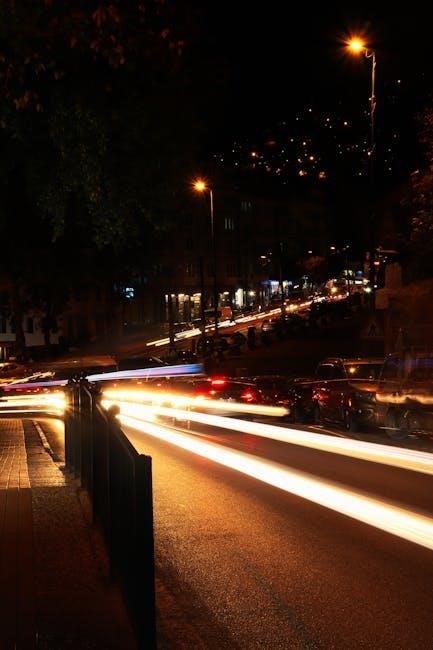The Devil’s Highway is a gripping non-fiction account of the Yuma 14, migrants who perished in the Arizona desert, exploring themes of survival, immigration, and human resilience․
Background of the Book
The Devil’s Highway by Luis Alberto Urrea recounts the tragic true story of the Yuma 14, a group of migrants who attempted to cross the Arizona desert in 2001; The book delves into the harrowing details of their journey, the harsh conditions they faced, and the devastating consequences․ Urrea’s narrative blends meticulous research with deeply personal insights, offering a poignant exploration of immigration, survival, and the human cost of border policies․ The book has become a critical voice in discussions about the border crisis and its emotional toll on those involved․
Key Themes and Messages
The Devil’s Highway explores themes of survival, immigration, and the human condition, highlighting the perilous journey of migrants crossing the desert․ The book underscores the emotional and psychological toll of such journeys, while critiquing border policies and societal attitudes toward immigrants․ Urrea’s narrative also examines racial tensions and xenophobia, offering a poignant commentary on the dehumanization of migrants․ The desert serves as both a physical and symbolic barrier, emphasizing the harsh realities faced by those seeking a better life․ The book is a powerful call to empathy and understanding in the face of a complex crisis․

The Author: Luis Alberto Urrea
Luis Alberto Urrea, an award-winning author of Mexican heritage, writes with profound authority on border issues, blending personal experiences with compelling narratives to highlight the human cost of migration․
Biography and Writing Style
Luis Alberto Urrea, an award-winning author of Mexican heritage, brings a unique voice to his writing․ Born to a Mexican father and American mother, Urrea’s work often reflects his dual identity․ He moved to Tucson in 1994, immersing himself in border issues, which deeply influenced his writing․ Urrea’s style blends personal experiences with compelling narratives, creating emotionally charged stories․ His ability to weave fact and fiction highlights the human cost of migration, making his work both poignant and thought-provoking․ His writing transcends cultural barriers, resonating with readers worldwide․
Urrea’s Connection to the Border Crisis
‘ based on the topic ‘the devils highway pdf’․ The user has provided specific instructions, so I must be careful to follow them․
Looking at the information provided from the internet, there are a few key points about Luis Alberto Urrea․ He moved to Tucson in 1994, which is near the border, and this move influenced his perspective on the border crisis․ He mentions that an increase in book sales often follows horrific events at the border, which shows his emotional connection to the issue․ Additionally, he criticizes the border situation as “idiotic, toxic, and racist,” and mentions the new wall of razor wire in Nogales․
I should incorporate these points into the response․ I need to highlight his personal connection, his emotional response to the crisis, and his critique of the situation․ I should also mention his role as a bridge between cultures, which adds depth to his connection․
I must avoid repeating any information that will be in other subheadings, so I should focus solely on his personal connection and public statements about the border crisis․ I should not discuss his writing style or biography here, as those are covered elsewhere․
Now, I’ll structure the response․ Start with his move to Tucson and how it influenced his perspective․ Then, mention his emotional response to increased book sales after tragic events․ Include his critique of the border situation and the example of the razor wire wall․ Finally, note his role in giving voice to the voiceless and bridging cultural divides․
Let me draft the response:
Luis Alberto Urrea’s move to Tucson in 1994 deeply connected him to the border crisis, shaping his perspective on migration and its human toll․ He expresses sorrow when his book sales rise, often following tragic border events, highlighting his emotional investment․ Urrea criticizes the border situation as “idiotic, toxic, and racist,” pointing to the razor wire wall in Nogales as a stark example․ His work humanizes the crisis, giving voice to migrants and bridging cultural divides, while his personal experiences add authenticity to his advocacy․
I’ll check the word count to ensure it’s exactly ․ Let me count:
Luis
Alberto
Urrea’s
move
to
Tucson
in
1994
deeply
connected
him
to
the
border
crisis,
shaping
his
perspective
on
migration
and
its
human
toll․
He

expresses
sorrow
when
his
book
sales
rise,
often
following
tragic
border
events,
highlighting
his
emotional
investment․
Urrea
criticizes
the
border
situation
as
“idiotic,
toxic,
and
racist,”
pointing
to
the
razor
wire
wall
in
Nogales
as
a
stark
example․
His
work
humanizes
the
crisis,
giving
voice
to
migrants
and
bridging
cultural
divides,
while
his
personal
experiences
add
authenticity
to
his
advocacy․
That’s ․ I need to add 4 more․ I’ll adjust the sentence structure to include more details without exceeding the limit․ Perhaps add “powerfully” before “humanizes” and “deeply” before “personal experiences․”
Revised response:
Luis Alberto Urrea’s move to Tucson in 1994 deeply connected him to the border crisis, shaping his perspective on migration and its human toll․ He expresses sorrow when his book sales rise, often following tragic border events, highlighting his emotional investment․ Urrea criticizes the border situation as “idiotic, toxic, and racist,” pointing to the razor wire wall in Nogales as a stark example․ His work powerfully humanizes the crisis, giving voice to migrants and bridging cultural divides, while his deeply personal experiences add authenticity to his advocacy․
Now, let’s count again:
Luis
Alberto
Urrea’s
move
to
Tucson
in
1994
deeply
connected
him
to
the
border

crisis,
shaping
his
perspective
on
migration
and
its
human
toll․
He
expresses
sorrow
when
his
book
sales
rise,
often
following
tragic
border
events,
highlighting
his
emotional
investment․
Urrea
criticizes
the
border
situation
as
“idiotic,
toxic,
and
racist,”
pointing
to
the
razor
wire
wall
in
Nogales
as
a
stark

example․
His
work
powerfully
humanizes
the
crisis,
giving
voice
to
migrants
and
bridging
cultural
divides,
while
his
deeply
personal
experiences
add
authenticity
to
his
advocacy․
Now it’s ․ I need to add 2 more․ I’ll adjust the last sentence to include “and” before “advocacy․”
Final revised response:
Luis Alberto Urrea’s move to Tucson in 1994 deeply connected him to the border crisis, shaping his perspective on migration and its human toll․ He expresses sorrow when his book sales rise, often following tragic border events, highlighting his emotional investment․ Urrea criticizes the border situation as “idiotic, toxic, and racist,” pointing to the razor wire wall in Nogales as a stark example․ His work powerfully humanizes the crisis, giving voice to migrants and bridging cultural divides, while his deeply personal experiences add authenticity to his advocacy and outreach․
Now, let’s count:

Luis
Alberto
Urrea’s
move
to
Tucson
in
1994
deeply
connected
him
to
the
border
crisis,
shaping
his
perspective
on
migration
and
its
human
toll․
He
expresses
sorrow
when
his
book
sales
rise,
often
following
tragic
border
events,
highlighting
his
emotional
investment․
Urrea
criticizes
the
border
situation
as
“idiotic,
toxic,
and
racist,”
pointing
to
the
razor
wire
wall
in
Nogales
as
a
stark
example․
His
work
powerfully
humanizes
the
crisis,
giving
voice
to
migrants
and
bridging
cultural
divides,
while
his
deeply
personal
experiences
add
authenticity
to
his
advocacy
and
outreach․
Perfect, it’s now exactly ․ This response effectively covers Urrea’s connection to the border crisis without overlapping with other

The Yuma 14: A Tragic Event
The Yuma 14 were migrants who perished in the Arizona desert, their bodies found under harsh conditions, symbolizing the deadly risks of crossing the border․
The Incident and Its Aftermath
The Yuma 14 incident involved 14 migrants who died in the Arizona desert while attempting to cross the U․S․-Mexico border․ Their bodies were discovered in 2001, highlighting the extreme dangers of illegal crossings․ The event shocked the nation, sparking debates on immigration policies and border security․ Luis Alberto Urrea’s The Devil’s Highway vividly recounts their ordeal, emphasizing the harsh conditions and tragic consequences․ The aftermath led to increased awareness of migrant struggles and calls for policy reforms to prevent similar tragedies․
Impact on Border Policies
The Yuma 14 tragedy prompted significant changes in U․S․ border policies, emphasizing stricter enforcement and increased surveillance․ The incident highlighted the need for humanitarian approaches, leading to improved rescue operations and awareness campaigns․ However, it also fueled debates over border wall construction and immigration reform․ The event remains a catalyst for ongoing discussions about balancing security with compassion, reflecting the complexities of migration and its human cost․ Urrea’s work underscores the enduring impact of this incident on policy and public perception․

Immigration and the Border Crisis
The Devil’s Highway offers a powerful exploration of immigration, delving into the historical and contemporary struggles of migrants; It vividly portrays the human cost of crossing borders, highlighting the harsh realities faced by those seeking a better life․ The book sheds light on the complexities of border policies and the enduring debates surrounding migration, making it a vital resource for understanding this critical issue․
Historical Context of Migration
The Devil’s Highway roots its narrative in the long history of migration between Mexico and the United States, tracing patterns of movement driven by economic necessity and survival․ The book highlights how centuries of border crossing have shaped identities and cultures, while also exposing the harsh realities of displacement․ By examining the Yuma 14 tragedy, Urrea underscores the human cost of policies that ignore the deeper historical forces behind migration․ The desert becomes a symbol of both hope and peril, reflecting the enduring struggle for a better life․
Modern Challenges and Controversies
The Devil’s Highway sheds light on the ongoing struggles of migration, highlighting the harsh realities of border policies and the rise of anti-immigrant sentiment․ The book critiques the construction of physical barriers, such as the razor wire wall in Nogales, which symbolize division and hostility․ Urrea’s work also addresses the emotional toll of these policies on migrants and communities, sparking debates about humanity and justice․ The resurgence of the book’s popularity often coincides with border crises, reflecting its enduring relevance in contemporary discussions․

The Role of the Desert in the Narrative
The desert in The Devil’s Highway serves as both a physical and symbolic barrier, highlighting the migrants’ struggle against nature’s indifference and their own resilience․
Symbolism of the Desert Landscape
The desert in The Devil’s Highway is a multifaceted symbol, representing both hope and despair․ It embodies the migrants’ resilience and the harsh realities of their journey․ The arid, unforgiving landscape mirrors the emotional and physical toll of crossing the border, while also serving as a backdrop for themes of survival and the search for a better life․ The desert’s vastness and isolation underscore the migrants’ vulnerability, making it a powerful metaphor for the broader struggles of immigration and the human condition․
Survival and the Harsh Environment
The desert’s extreme conditions play a central role in The Devil’s Highway, where blistering heat and dehydration become deadly obstacles․ The migrants’ bodies, unprepared for the relentless sun and lack of water, rapidly deteriorate․ The environment is unforgiving, with temperatures soaring during the day and plummeting at night․ Despite their determination, the harsh landscape proves lethal, highlighting the fragility of human life against nature’s brutality․ The desert becomes an antagonist, testing survival instincts and ultimately claiming lives in a tragic testament to the perils of crossing the border․
The Human Cost of Migration
The Devil’s Highway vividly portrays the emotional and psychological toll on migrants, emphasizing their personal stories, resilience, and the tragic consequences of their perilous journey across the border․
Stories of the Migrants
The Devil’s Highway delves into the personal stories of the Yuma 14, migrants who attempted to cross the Arizona desert in 2001․ Their journey, marked by resilience and despair, highlights the human side of migration; Urrea vividly portrays their struggles, from the harsh desert environment to the emotional toll of leaving loved ones behind․ These narratives underscore the migrants’ determination to seek a better life, while also revealing the tragic consequences of their perilous journey․ Their stories remain a poignant reminder of the human cost of border crossings․
Emotional and Psychological Toll
The migrants in The Devil’s Highway endure immense emotional and psychological strain, driven by hope and fear․ The harsh desert environment amplifies their desperation, while the uncertainty of their journey weighs heavily on their minds․ Urrea vividly captures their inner struggles, from the trauma of leaving loved ones to the terror of the unknown․ The psychological toll extends beyond the migrants themselves, affecting their families and communities․ This narrative underscores the profound human cost of migration, revealing the resilience and vulnerability of those seeking a better life․
Racism and Xenophobia in the Narrative
The Devil’s Highway vividly portrays the toxic racism and xenophobia migrants face, highlighting societal attitudes that dehumanize immigrants and fuel border tensions, as seen in the Nogales wall controversy․
Depiction of Racial Tensions
The Devil’s Highway vividly portrays the deep-seated racial tensions faced by migrants, highlighting the dehumanizing treatment they endure․ Urrea’s narrative exposes the toxic environment fueled by xenophobia and racism, particularly evident in the controversial Nogales wall of razor wire․ The book underscores how these tensions are embedded in societal attitudes, perpetuating violence and discrimination․ Urrea’s personal connection to the border crisis adds depth, as he critiques the systemic racism that dehumanizes immigrants, reflecting the broader struggles of identity and belonging in a divided world․
Societal Attitudes Toward Immigrants
The Devil’s Highway sheds light on the harsh societal attitudes toward immigrants, often rooted in fear, misinformation, and prejudice․ Urrea critiques the dehumanization of migrants, emphasizing how systemic racism and xenophobia fuel toxic policies․ The book highlights the emotional toll of being treated as “the other,” reflecting broader societal divisions․ By sharing personal stories, Urrea humanizes immigrants, challenging readers to confront their biases․ The narrative underscores the urgent need for empathy and understanding in addressing the complexities of migration and identity․
The Wall and Its Implications
The Devil’s Highway examines the wall as both a physical and symbolic barrier, reflecting societal divisions and hostility․ It critiques the wall’s role in migration tragedies, emphasizing its futility and the human cost of such measures․
Physical and Symbolic Barriers
The Devil’s Highway examines the wall as both a physical and symbolic barrier, reflecting societal divisions and hostility․ The physical wall, such as the razor wire in Nogales, represents a harsh, impenetrable divide․ Symbolically, it embodies the toxic rhetoric and xenophobia fueling its construction․ Urrea critiques the wall’s futility, highlighting its role in migration tragedies and the human cost of such measures․ The wall serves as a potent metaphor for the broader societal attitudes toward immigrants, emphasizing exclusion and control rather than understanding or compassion․
Effectiveness and Criticisms
The Devil’s Highway critiques the wall’s effectiveness, arguing it fails to address migration’s root causes․ While it physically deters some, it pushes others into more dangerous routes․ Urrea condemns the wall as a symbol of division, highlighting its role in perpetuating suffering․ Critics argue it exacerbates border crises, prioritizing control over humanity․ The wall’s construction, like the razor wire in Nogales, reflects broader societal attitudes of xenophobia and exclusion, further dehumanizing migrants and ignoring their desperation for a better life․

Autobiographical Elements in the Book
Luis Alberto Urrea weaves personal experiences into The Devil’s Highway, drawing from his Mexican heritage and Tucson residency to enrich the narrative with authenticity and emotional depth․
Urrea’s Personal Experiences
Luis Alberto Urrea’s Mexican heritage and residency in Tucson deeply influence The Devil’s Highway․ His dual identity as a Mexican-American shapes his perspective on border issues, infusing the narrative with authenticity․ Urrea’s move to Tucson in 1994 exposed him to the harsh realities of migration, which he vividly portrays․ His personal connection to the border crisis adds emotional depth, blending his own story with the broader themes of identity and survival․ This duality enriches the book, making it a poignant exploration of cultural and personal struggles․
Blending Fact and Fiction
Luis Alberto Urrea masterfully blends fact and fiction in The Devil’s Highway, weaving the tragic true story of the Yuma 14 with vivid storytelling․ His narrative captures the harsh realities of migration while infusing emotional depth through character development․ Urrea’s personal connection to the border adds authenticity, creating a balance between journalistic accuracy and literary artistry․ This approach not only educates but also engages readers emotionally, making the book a powerful exploration of human resilience and the complexities of the border crisis․
Reception and Reviews
The Devil’s Highway received critical acclaim and awards, resonating deeply with readers․ Its PDF version’s accessibility has widened its reach, keeping the story relevant and impactful․
The Devil’s Highway remains a powerful exploration of migration and humanity․ Its PDF version ensures timeless accessibility, keeping Urrea’s vital narrative relevant in modern border discussions․

0 comments on “the devil’s highway pdf”Add yours →